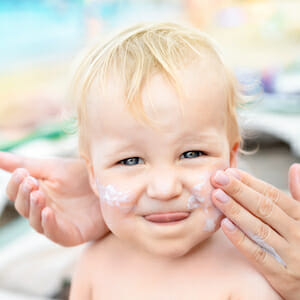Childhood Skin Issues
- Posted on: Jul 7 2021
 As a parent, you are often focused on keeping your kids healthy and promoting behaviors that support their overall well-being. But what about taking care of your child’s skin? Skin care for kids does not have to be a confusing process. To develop a safe and effective routine that promotes healthy skin, consider these skin care tips for childcare from our board-certified dermatologists.
As a parent, you are often focused on keeping your kids healthy and promoting behaviors that support their overall well-being. But what about taking care of your child’s skin? Skin care for kids does not have to be a confusing process. To develop a safe and effective routine that promotes healthy skin, consider these skin care tips for childcare from our board-certified dermatologists.
Skin Care for Children That Helps Prevent Dry Skin
Ensuring your child’s skin is clean and moisturized is a priority in any children’s skin care routine. Children’s skin loses moisture faster than an adult’s, so it is important to keep your child’s skin hydrated to prevent dryness and irritation.
Baths
Taking a bath once a day in lukewarm water is a great way to remove harmful irritants while also introducing moisture to the skin. Be sure that your child uses a mild, unscented soap, cleanser, or body wash. After bathing, it is best to use a towel to gently pat the child’s skin dry. Choose any of these soaps and cleansers that have a reputation for being gentle on skin:
- Cetaphil Cleanser
- Cerave Soap
- Dove for Sensitive Skin
- Purpose Cleanser
- Vanicream Soap
Moisturizers
Using moisturizer is a must. It will prevent dry, itchy skin and help your child feel more comfortable. You can use a moisturizer several times throughout the day as part of your children’s skin care routine. However, applying it right after a bath is the best way to lock moisture into the skin and keep it hydrated. Ointments and creams are thicker and more hydrating than lotion, which are usually thinner and not as effective as moisturizers. Add any of these unscented, hydrating moisturizers to your skincare routine for kids:
- Vaseline
- Cetaphil Cream
- Aveeno Advanced Care
- Eucerin Cream
- Vanicream
- Cerave Cream
- Aquaphor Ointment
The Importance of Sunscreen in a Skincare Routine for Kids
According to the Skin Cancer Foundation, experiencing just one blistering sunburn as a child or adolescent more than doubles the risk of developing melanoma as an adult. This is why skin care for children should always include a daily application of sunscreen.
The first step towards protecting your child’s skin from the sun’s harmful rays starts with selecting the right sun block. With so many different sunscreens available, how do you choose the right one? Our dermatologists recommend these tips for selecting the right sunscreen when deciding on skin care for children:
- Choose a broad-spectrum sunscreen. A broad-spectrum sunscreen provides protection from UVA and UVB rays, which are the damaging rays that are responsible for sunburns, wrinkles, skin damage, and skin cancer.
- Choose a sunscreen that is water-resistant and has at least SPF 30.
- Use a sunscreen containing titanium dioxide or zinc oxide. Sunscreens containing these ingredients are considered physical sunscreens, which means that they provide protection from the sun’s harmful rays by physically blocking them from penetrating the skin. This is unlike chemical sunscreens, which absorb the sun’s rays and converts them into heat before releasing them from the body.
Now that you know how to select the right sunscreen to include in your skin care for children routine, follow these sun safety tips to protect your children from the sun:
- It’s best to apply sunscreen 20-30 minutes before your child goes outside since it takes about 30 minutes to start working.
- Apply enough SPF 30 sunscreen to cover all exposed skin, including easily overlooked areas such as ears, backs of knees, hands, and tops of feet.
- Even if your sunscreen is water-resistant, make sure to reapply it every two hours. If your child is sweating a lot or spends time swimming or playing other sports, be sure to reapply more frequently.
Avoid These Ingredients in Your Children’s Skin Care Routine
Children’s skin is usually more sensitive to irritants in comparison to adults, and it is common for kids to experience allergies or skin irritation to synthetic ingredients. When developing your skin care for kids routine, our dermatologists recommend avoiding these potentially harmful ingredients:
- Sunscreen chemicals: avobenzone, homosalate, benzophenone, methoxycinnamate, and PABA
- Parabens: Commonly found in deodorants, shampoos, body washes, and facial cleansers, parabens function as preservatives, but they can irritate the skin of children.
- Fragrance: Products containing fragrances have an increased risk of causing dermatitis, allergies, and even respiratory issues. Opt for fragrance-free skin care products instead.
- Synthetic dyes: Avoid products with D&C and FD&C in the ingredients list. These are color additives derived from petroleum that are potential irritants to kids.
- Formaldehyde: This chemical is commonly found in body washes, conditioners, and shampoos, but it can cause skin irritation and allergies in children.
- Propylene glycol: You’ll find propylene glycol in sunscreens and moisturizers since it functions as a skin conditioner, but it can cause hives and dermatitis, even in low amounts.
- Sodium lauryl sulfate (SLS) and Sodium laureth sulfate (SLES): Sulfates are found in many body washes and shampoos, but they can irritate the skin, lungs, and eyes.
Make an appointment at Asarch Dermatology to learn more about taking the best care of your child’s skin and choose the skincare routine for kids that is perfect for you child. Our dermatologists will take the time to explain more skin care tips for child summer care and can help your child achieve healthy skin.
